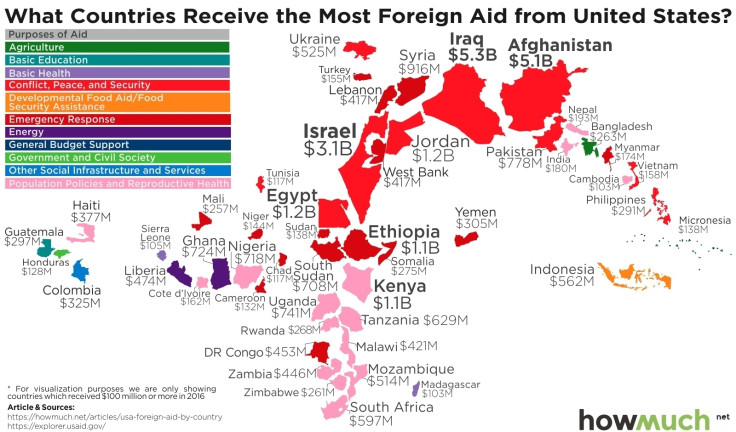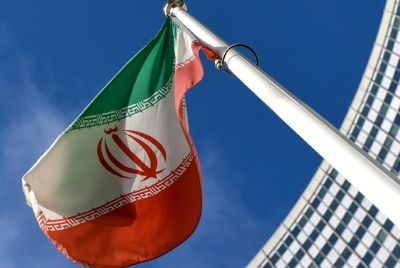Map of US foreign aid spending shows how much goes to countries opposed to Jerusalem embassy move
US threatened to cut aid to UN member states who didn't recognise Jerusalem as the capital of Israel.

This map shows what the US spends on foreign aid to other countries, according to 2016 data.
Cost information website How Much compiled the data to visualise where US foreign aid goes and to what extent it is used. Country sizes are scaled based on how much help they receive rather than familiar dimensions.
How Much based their visualisation on 2016 data from the United States Agency for International Development (USAID) and only displayed countries that received $100m or more in aid in 2016.
In total, the US spends more than $18.3bn in conflict reduction. Iraq, Afghanistan and Israel receive the biggest sums of money - $5.3bn, $5.1bn and $3.1bn in aid respectively.
The figures have been compiled in the wake of US President Donald Trump threatening to cut aid to UN members who voted against the United States' decision to recognise Jerusalem as Israel's capital and move its embassy to the city.
The UN General Assembly voted overwhelmingly on 21 December to denounce President Donald Trump's recognition of Jerusalem as Israel's capital, largely ignoring Trump's threats.
The nonbinding resolution declaring US action on Jerusalem "null and void" was approved 128-9 — a victory for the Palestinians, but not as big as they predicted. Amid Washington's threats, 35 of the 193 UN member nations abstained and 21 were absent.
The resolution reaffirmed what has been the United Nations' stand on the divided holy city since 1967: that Jerusalem's final status must be decided in direct negotiations between Israel and the Palestinians.
The Trump administration made it clear the vote would have no effect on its plan to move the American Embassy from Tel Aviv to Jerusalem. And Israeli Prime Minister Benjamin Netanyahu said afterward that he completely rejects the "preposterous" resolution.
Palestinian Ambassador Riyad Mansour called the vote a victory not only for the Palestinians but for the United Nations and international law, saying U.S. Ambassador Nikki Haley "failed miserably" in persuading only seven countries aside from the U.S. and Israel to vote against the resolution.
The United States and Israel had waged an intensive lobbying campaign against the measure, with Haley sending letters to over 180 countries warning that Washington would be taking names of those who voted against the U.S. Trump went further, threatening a funding cutoff: "Let them vote against us. We'll save a lot. We don't care."
But in the end, major U.S. aid recipients including Afghanistan, Egypt, Jordan, Pakistan, Nigeria, Ethiopia, Tanzania and South Africa supported the resolution. Egypt received roughly $1.4 billion in U.S. aid this year, and Jordan about $1.3 billion.
The nine countries voting "no" were the U.S., Israel, Guatemala, Honduras, Micronesia, Nauru, Palau, the Marshall Islands and Togo. Among the abstentions were Australia, Argentina, Canada, Colombia, Croatia, Czech Republic and Mexico.
The absent countries included Kenya, which was the fifth-largest recipient of U.S. aid last year, Georgia and Ukraine, all of which have close U.S. ties.
After the vote, Haley tweeted a photo naming the 65 nations that voted no, abstained or were absent, and said: "We appreciate these countries for not falling to the irresponsible ways of the UN."
The U.S. is scheduled to dispense $25.8 billion in foreign aid for 2018. Whether Trump follows through with his threat against those who voted "yes" remains to be seen.
But within hours, the Trump administration appeared to be backing away from its funding threats. In Washington, State Department spokeswoman Heather Nauert said cuts to countries that opposed the U.S. are not a foregone conclusion.
"The president's foreign policy team has been empowered to explore various options going forward with other nations," Nauert said. "However, no decisions have been made."






















